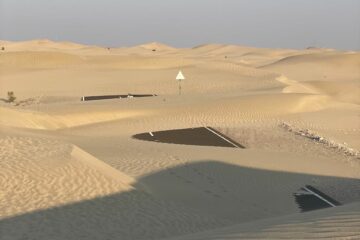Disney Robot beachbot


Introduction:
While there are already lots of robots engaged in drawing and painting activities previously, Beachbot takes art to an entirely new level. Crafted by a collaborative effort between Disney Research Zurich and ETH Zurich, this remarkable robot possesses the ability to independently craft sand drawings by skillfully taking a rake-like tool across the beach’s expanse itself.
Concept:
The principal research scientist at Disney Research Zurich mentioned the reason of doing this project is to explore a less permanent medium. “Sand drawing is perfect because it’s an infinitely reuseable canvas”.
Technical implementation:
The BeachBot employs a rake equipped with seven movable components driven by servo motors, all affixed to the robot’s rear. This innovative configuration enhances the visibility of the created drawings and provides a wide range of line widths. For precise drawing, the BeachBot relies on accurate localization. This involves a laser scanner mounted on the robot and reflective poles that demarcate the drawing area. This setup enables the laser to generate a dynamic map of its surroundings. To endure the harsh beach environment, the robot must remain completely impervious to sand. To achieve this, it features a robust aluminum shell and sealing lips that effectively prevent any sand from getting into its interior.
The Programmable Robotic Zen Garden

Introduction:
If magnets had the capacity for meditation; they might find themselves creating something similar to the mesmerizing zen gardens featured in Bruce Shapiro’s continuous Sisyphus project. In this artistic endeavor, Shapiro employs a motion control system to intricately carve patterns into the sand. The actual labor is carried out by a small metal ball, powered by magnets, tirelessly adorning beautiful patterns—a process that has a striking resemblance to the ceaseless toil of the legendary boulder in Greek mythology after which the project is named.
Concept:
The artist tries to explore the field of motion control. Motion control is an industry term for computer-controlled movement in applications like robotics and CNC. This technology has revolutionized industrial production and design, but until more recent times, its complexity and expense has placed it out of the reach of most artists. SHAPIRO said:” I have spent the past 25 years dedicated to exploring motion control as a new medium for artistic expression, building CNC art tools and kinetic sculpture that combine my love of art, science, and education.”
Technical implementation:
Beneath the table, there’s a robot called “Sisbot” with two motors. This robot moves a magnet that pulls a steel ball around in the sand. It’s controlled by a small computer called Raspberry Pi, which is a bit like a music player for paths (like songs in music). When you plug in Sisyphus, it starts up automatically. It figures out what to do, loads a list of paths to follow, and begins moving the ball. You can control how it moves, the speed, and the table’s lighting using a mobile app or a web browser connected to Sisyphus through Wi-Fi.
Robot Gardener

Introduction:
“The Constant Gardeners” is an interactive art installation where Jason Bruges and his team have ingeniously programmed four industrial robotic arms to craft intricate patterns in real time on a Zen rock garden. This garden comprises 14 tonnes of crushed black basalt set amidst 4 tonnes of silver-grey granite. Throughout the day, spectators have the opportunity to witness up to four distinct illustrations being created, each taking between 30 minutes and two hours to finish, depending on its intricacy. These captivating artworks are displayed for a duration of 30 minutes to an hour before the robots meticulously prepare the surface for their next masterpiece. Over the course of the event, these robots will produce a total of 150 different illustrations.
Concept:
The designs it generates mirror the motions of athletes and draw inspiration from various Olympic and Paralympic sports. By using these second-hand industrial robots for art, the team invites people to reconsider the role of machines in daily life and highlights their potential in experimental creative projects. Visitors are encouraged to think differently about these machines and look beyond the scary sci-fi tropes of the killer robot.

Robot Gardener by Jason Bruges.
Zenbot

Introduction:
In the digital age of constant buzz, the team was driven to find a way to drown out the noise by creating an opportunity to meditate and reconnect with nature. This collective need inspired us to explore ways to carve out our own piece of solace, Zenbot.
Concept:
Following the design principle of wabi-sabi, embracing imperfection, and appreciating the ingenuous integrity of natural objects and processes, the project sought out ways people could highlight imperfections of human design and the precision of a robot. Zen garden symbolizes both robot-kind and humanity coming together. By exchanging polarizing traits and entering a meditative dialogue with one another, the artists generate a new kind of beauty. Imperfectly perfect – Perfectly imperfect.
Castles Made of Sand

Introduction:
“Castles Made of Sand is a site-specific installation conceived to be temporarily installed in a small office space located near the top of a skyscraper in downtown Toronto. The installation functions as a production line that builds sand castles, dispatches them for a journey along a conveyor belt, and eventually sends them forward to crumble. The sand is then collected and recycled to create a new castle. This cyclical construction and destruction of the castle is set to the relative position of the moon in the sky as it influences the tides. As this astronomical phenomena triggers this cycle, passersby can witness the rise and fall of castles – ephemeral architectures that drift past the windows and topple down in front of the city skyline.”
Concept:
“Operating at a very slow pace, Castles Made of Sand actively decelerates the mechanical process; producing a contemplative experience in which frail fortresses expose a vulnerable temporal existence while at the same time enabling a perpetual new beginning.”


